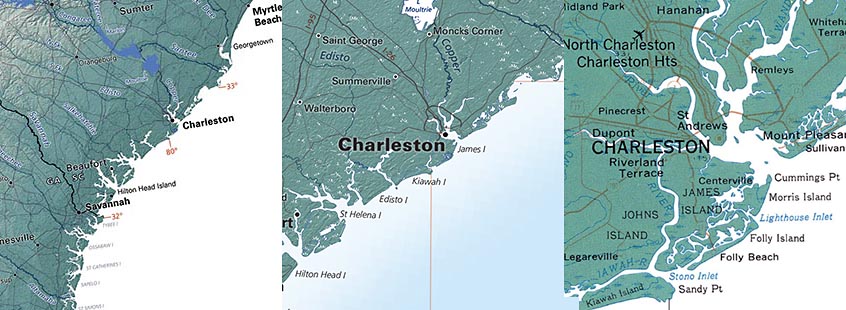We recently received a comment stating that we had mislabeled a suburb near Charleston, South Carolina. A quick check explained the problem, and got us thinking about naming conventions, map scales, map legends, and the way they all interact. It was an instructive misunderstanding.
We do sometimes make labeling mistakes, and we are grateful (if chagrined) to hear about them. This time, however, the writer was confusing a physical feature name (“James Island”) with a town of the same name which we did not identify. The position of the name further suggested to the writer that we had misplaced the name for the town of James Island in the actual location of another much smaller community, Folly Beach.
We use different type fonts for physical feature names and for towns (“populated place” names, in cartographic jargon). Town names are positioned in relation to black dots. And, we name only the most important towns, since Raven maps are particularly focused on the physical landscape which most maps downplay or ignore. The more comprehensive the names, the less legible the landscape details and the names themselves.

Charleston on the US map, a Regional map, and the map of South Carolina
“Most important” depends upon the map scale, of course. Charleston is important enough to show up on just about any map of the United States. Many of its suburbs are named on Raven’s South Carolina state map, at a scale of 8 miles to the inch. The comment apparently related to one of our Regional Maps, however, at a scale of 32 miles to the inch. (The series includes generous overlap, so Charleston shows up on three of them: the Gulf Coast, South Atlantic, and Appalachians & Ohio River Valley maps). Including the names of places as small as Folly Beach at that scale would mean printing a map covered entirely by populated place names.
We used to include more legend detail (about fonts, elevation data, selection criteria, etc) than we do now. Over the years we've learned that few map users pay any attention to legends, and there’s no room for the long explanations that a fully accurate description often requires.
We have to assume a certain level of common sense and an understanding of context, and hope that, most of the time, it works.

